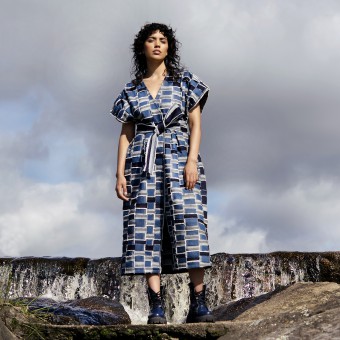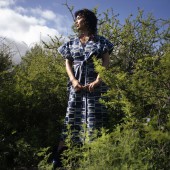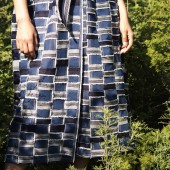Entrelazos Kimono Coat by Soledad Saint-Phat |
Home > |
 |
|
||||
| DESIGN DETAILS | |||||
| DESIGN NAME: Entrelazos PRIMARY FUNCTION: Kimono Coat INSPIRATION: The inspiration comes from the recovered culture, from ancestral techniques that tell different stories over time. Entramar, a Spanish word that describes the lattice not only of the materials but also of the social interweaving, is the key word as an inspiration. The story woven from the warp to the people involved in its creation. From the being to the sustainable doing. This piece speaks of sustainability in the broadest sense, of fraternity and identities intertwined towards a common goal. UNIQUE PROPERTIES / PROJECT DESCRIPTION: The Kimono Coat is made entirely from recycled textile scraps collected by the Sustainable Textile Centre of the Municipality of Cordoba. By interweaving strips of fabric and designing repeating patterns, this unique textile is created with different shades of indigo to create an interwoven texture. It represents the possibility of reducing industrial textile waste from local companies and the network involved in the different stages of a finished garment. It's body inclusive and genderless. OPERATION / FLOW / INTERACTION: The kimono coat is very easy to access as it can be opened without buttons and has a removable belt so it can be adjusted around the waist if required. It can also be worn without a belt . PROJECT DURATION AND LOCATION: The Kimono Coat was presented for the first time as a preview in December 2022 in a local sustainable fashion show and in March 2023 in a Latinamerica event for sustainable designers in Punta del Este, Uruguay. Later the same year was featured in a design digital magazine. FITS BEST INTO CATEGORY: Fashion, Apparel and Garment Design |
PRODUCTION / REALIZATION TECHNOLOGY: Made from denim scraps from local textile companies. It starts from the selection of the discards, then an appropriate washing and ironing. Having in mind a selected pattern that molds to the chosen discard, each of the textile strips are manually intertwined to achieve a textile canvas in three central panels seated on ecological paper to allow the following steps. Pre sewing by hand, cutting the pattern and sewing by a sewing machine are the next steps. Using as few new materials as possible, such as thread for sewing and stitching was a main factor to this sustainable piece construction. SPECIFICATIONS / TECHNICAL PROPERTIES: With 700 x Height 1230 With is calculated shoulder to shoulder and height is calculated from top shoulder to the bottom of the piece. TAGS: Sustentability, slow fashion, denim, handmade, textile waste RESEARCH ABSTRACT: The research emerged from the generation of hand weaving techniques and the relationship with recycled textiles. The main objective was to reduce the amount of new material used in the construction of the garment, using only sewing thread and cotton bias binding to clean the internal seams. In the case of the Kimono Coat, the textile sustainability goals are not only related to the recovery of fabrics, but also to having the least impact on the production process of the finished garment. CHALLENGE: One of the creative challenges was to design a pattern as an illustration with small textile waste that could be repeated throughout the entire garment. On the other hand,one of the biggest technical challenges was to control the weight of the garment. The total weight of the recovered small-format textile waste can have a negative impact on the weight of the finished garment, which is why I took into account the need to avoid lining in order to achieve a balance. In this way the work of the garment was meticulouse so the design patterncan be observed both, externally and internally. ADDED DATE: 2024-03-04 18:55:16 TEAM MEMBERS (1) : IMAGE CREDITS: Image #1: Photographer María Luciana Reina, 2023. Image #2: Photographer María Luciana Reina, 2023. Image #3: Photographer María Luciana Reina, 2023. Image #4: Photographer María Luciana Reina, 2023. Image #5: Photographer María Luciana Reina, 2023. Model: Valentina Chiecher. |
||||
| Visit the following page to learn more: https://www.instagram.com/soledadsaintph |
|||||
| AWARD DETAILS | |
 |
Entrelazos Kimono Coat by Soledad Saint-Phat is Runner-up for A' Design Award in Fashion, Apparel and Garment Design Category, 2023 - 2024.· Press Members: Login or Register to request an exclusive interview with Soledad Saint-Phat. · Click here to register inorder to view the profile and other works by Soledad Saint-Phat. |
| SOCIAL |
| + Add to Likes / Favorites | Send to My Email | Comment | Testimonials |







